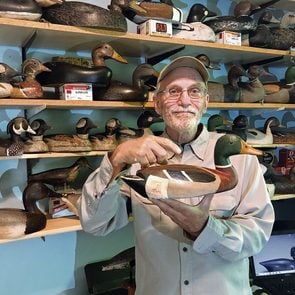
If your fridge has a built-in ice machine, you may have occasionally noticed the ice cubes coming out grey in color. When this first happened to me, I didn’t know what to make of it. Was my fridge broken? Had my ice been contaminated somehow? Thankfully neither hypothesis was correct. That said, grey ice cubes in your fridge’s ice maker shouldn’t be ignored. Learn exactly what causes this unpleasant occurrence and the proper way of dealing with it.
What Causes Grey Ice Cubes?
The three most common causes of grey ice cubes from your fridge’s ice maker are dirt in the ice maker, charcoal sediment from a fresh filter or an old filter that needs to be replaced. Let’s take a look at each scenario.
Dirt in the ice maker
Like all parts of your fridge and freezer, the bins in ice makers accumulate dirt and debris. Over time this unwanted material can bond to ice cubes as they’re dispensed into the tray, giving the cubes a grey, discoloured appearance.
Charcoal sediment from fresh filter
Nearly all modern fridges equipped with ice makers and water dispensers have replaceable filters inside to keep the water and ice clean. Most of these filters rely on carbon to get the job done since it’s good at absorbing impurities.
Water enters the fridge through a supply line, where it’s forced through a cylindrical filter packed with a block of compressed carbon before reaching the ice maker and water dispenser. As you might expect, these filters need to be replaced from time to time. New filters always have some loose carbon particles inside which are fine enough that they exit the filter along with your water. Small black particles of carbon in your fridge’s water can quickly lead to grey ice cubes.
An old filter that needs replacement
Eventually, fridge filters stop doing their job, and begin letting unwanted substances through and into the fridge’s water dispenser and ice maker. This can quickly lead to greyish ice cubes. Most manufacturers recommend fridge filter replacement roughly every six months depending on the water volume used.
How to Resolve the Issue
If your freezer has started spitting out grey ice cubes, cleaning your ice bin is the first and easiest thing to try. Unplug the refrigerator, then remove all the ice from the ice bin in the freezer. Take the ice bin out, then thoroughly wash it with soap and water. If lots of dirt comes off, chances are you’ve discovered the reason for your grey ice. Dry the ice bin carefully, then replace it in the fridge and plug the fridge back in. When the ice maker has a chance to make a new batch of ice cubes, check them out. If your ice bin was dirty, the new batch of ice will now be clean and normal in colour.
If you suspect your issue stems from the fridge filter, that’s where you should look next. Most filter-related grey ice problems happen because a fresh filter has been installed but not flushed. New carbon filters in fridges often give off small amounts of carbon particles for a while, leading to grey ice cubes. Solve the problem by running 2 to 3 gallons of water through your filter via your fridge’s water dispenser. This is known as “flushing” the filter. It should be enough to wash away all the loose carbon particulate in your new filter. If your fridge doesn’t have a water dispenser, dispose of the first couple of batches of ice after filter replacement.
Next, find out if your freezer is set to the right temperature.
When seasons shift and the days get shorter, people all over the world experience the so-called winter blues. Some of us also suffer from a more severe variety called seasonal affective disorder—a depression caused by a lack of exposure to direct sunlight. For this condition, scientists have found sitting for 30 minutes a day in front of a specially designed lamp that emits a bright white light can help. In fact, this treatment can be as effective as antidepressants—and a 2015 study found that it could even help patients whose depression is non-seasonal.
The sun emits different kinds of light, some of which are more beneficial than others. The shortest wavelength is ultraviolet and the longest is infrared; in between are all the familiar colours of visible light. Research into the benefits of light therapy has been taking place for more than a century. In the early 1900s, it was recommended for everything from treating tuberculosis to generating hair regrowth. But it became less popular after the discovery of antibiotics and the rise of the pharmaceutical industry. Plus, many of the extraordinary claims about the benefits of light therapy tested credulity.
Applications of Red Light Therapy
In the last decade, however, driven by a surge of encouraging trials, light therapy has made a comeback—including in clinics and hospitals. Red light in particular is being studied for its ability to help ease the symptoms of serious health problems, such as Parkinson’s, Alzheimer’s and carpal tunnel. (Learn to spot the early symptoms of Parkinson’s.) Even though many of these applications are still awaiting government approval, red light is already being administered in hospitals in Europe, Canada and South America to treat macular degeneration.
Red light’s special healing properties are linked to its ability to activate mitochondria, cellular structures that play a role in combatting these conditions. As Janis Eells, a professor of biomedical sciences at the University of Wisconsin-Milwaukee, describes it, light can give cells a “kick in the mitochondrial pants”—basically waking them up and prompting them to do their job.
Light therapy is being used in more common, everyday applications, too. Red and near-infrared light are capable of reaching cells beneath the skin to accelerate the healing of bruises and wounds. This treatment can be done at many beauty salons or with a home unit: people tend to expose themselves for five to 15 minutes once a day until the wound heals. (For a safe and effective treatment, it’s best to consult a doctor before using red light.)
Benefits of Blue Light Therapy
Blue light, which can reach just under the epidermis, is commonly prescribed by dermatologists—and administered at home or in the office—to kill acne-causing bacteria on the skin.
Research into Green Light
Green light is not as well understood, but a 2020 study from the University of Arizona indicates that it might serve as a preventive therapy for patients with recurrent migraines. After 10 weeks of self-administered exposure for one to two hours a day, patients reported an average 60 per cent reduction in pain. These are promising preliminary results, but medically approved clinical use is likely still a few years away, Eells says.
Now that we are beginning to understand how and why light can heal us, Eells is encouraged that we’re overcoming the skepticism that plagued light therapy in the past. “It’s not magic,” she says. “It really is science.”
Now that you’re up to speed on the benefits of light therapy, find out more ways to beat seasonal affective disorder.
On the first morning of a three-day family vacation in St. John’s, my husband asked our chatty cab driver what made him most proud to be a Newfoundlander.
“Our generosity and hospitality,” he replied in a strong local accent. “If your car breaks down in the middle of nowhere, you won’t be left alone. Someone will pick you up, help you out and probably drive you home if you need. People here are kind like that.”
We’d heard of the Broadway musical Come From Away, which is about how 7,000 stranded airline passengers were generously housed in Gander, Newfoundland, when their flights were grounded on 9/11. But could spontaneous kindness be the common quality of an entire province? Is it possible for attitudes and habits to spread through communities like a virus? The question lingered in my mind during that ride to the famous historical landmark Signal Hill with my husband and our two teenage kids.
Little did I know we were about to have a chance to experience some of this remarkable Newfoundland and Labrador generosity ourselves.
The unusual offer
We met Alma by Signal Hill, at the start of the North Head Trail—the one that overlooks St. John’s and its harbour to the west and the Atlantic to the east. On that bright, blue-sky summer day in 2017, the view was vaster and more alluring than we’d ever imagined.
Our kids hurried ahead, and as we lagged, admiring the scenery, two women in sunglasses and light hiking gear stopped. They’d heard us discussing different routes and asked if we’d like suggestions. They looked to be in their 40s, one blond and one brunette, full of energy and both enthusiastic to share their expertise. We listened eagerly, taking mental notes, until the pleasant blond lady asked, “You have a car, right?”
I explained that they were out of cars at the rental agency, so we’d settled on taking cabs to the different hikes.
“Oh no,” she said, “you need a car.” And then, as casually as if offering a squirt of sunblock, she said: “Take mine!”
Dumbfounded, my husband and I just smiled in disbelief.
“Why not?” she insisted. “Take my car; I won’t need it. You need a car to get to know all these places.”
“But you don’t even know us,” I said.
“That doesn’t matter,” she continued. “Do you have a licence?”
Stunned, I looked over at her friend. The brunette smiling from behind her sunglasses shrugged and said, “That’s Alma.”
I walked away, not sure of what to make of it all. Alma later told me that I seemed visibly distressed, as if I couldn’t handle the situation. The fact was that I had neither the rudeness to refuse nor the resolve to accept.
Alma and her friend Renée continued talking with my husband. I could hear him telling them more about us.
“We’re from Uruguay,” he explained, “but we live in Ottawa.” This brief detail only seemed to make Alma more determined.
“Oh, you have to take the car, then. You came all the way here? You’re only here for two more days?”
Forty minutes of hiking later, my family was cramming into the back of Renée’s car, while Alma squeezed into the passenger side, holding her friend’s empty child seat. Renée was giving us a lift to a nearby parking lot, where Alma’s car awaited.
A special bond is forged
“We’ll need your address, Alma, so we can return your car,” I said. This simple comment drew nervous laughter from all of us, as if we were giddy kids in on a secret.
Everyone, that is, except my 14-year-old daughter, a young lady with a keen sense of ownership. “There is,” she said as our family finally climbed into Alma’s black Acura, “something seriously wrong with what we are doing.”
Thanks to Alma, we spent the remainder of our time in St. John’s discovering the majestic East Coast Trail and its bordering cliffs, where the scent of sea air mingled with spruce trees. We watched pods of whales swim nearby. It didn’t take long to confirm that Newfoundland—remote, unique and unforgettable—was a place we’d done well to visit.
Every so often, as my family explored the countryside in her car, we texted Alma to let her know everything was okay. She texted back, saying that she’d told her husband, Ed, about her decision, and he was fine with it. For our final evening, Alma invited us over for dinner. She and Ed made us feel immediately at home. We shared impressions of our peculiar meeting as if we were discussing a movie we’d recently seen starring ourselves.
Since returning to Ottawa, I have exchanged emails with Alma. She reminds me that we were “hard nuts to crack,” but she is grateful that we allowed her to help us. I tell her how our story astounds me all over again, each time I tell it.
People have different responses: some say it’s incredible; most agree they’d never lend their car to a stranger—but those who’ve been to the province are not surprised.
The reaction that stays with me most is what Alma’s brother told her when she texted him that she had just lent her car to a family of strangers. He wrote, simply, “That’s how you make new friends.”
I no longer doubt that, at least in Newfoundland, random acts of kindness are an epidemic.
Check out more inspiring acts of kindness that will make you proud to be Canadian.

A Medical Mystery
Tereka Eanes can’t remember a time when her stomach didn’t hurt. Growing up in Huntington, West Virginia, she constantly battled aches, cramps and diarrhea. And for most of her early life, doctors shrugged off her concerns. As Eanes entered her 20s, they finally began running tests, but nothing definitive came of them. Instead, specialists guessed that she might have a problem with her gallbladder, or irritable bowel syndrome. They recommended that she avoid certain foods and reassured her that nothing seemed seriously wrong.
But in 2001, when Eanes was 28 and working as a hairstylist, her symptoms worsened—she was spending countless hours on the toilet, hoping her abdominal pain would go away. Convinced that she was experiencing more than mere run-of-the-mill tummy troubles, she visited Cabell Huntington Hospital, where a doctor ordered an X-ray of her stomach. When the results came back, the technician seemed confused. She fetched a few more hospital staff to analyze the scan before she finally told Eanes, astounded, “Your stomach is on the wrong side.”
That wasn’t all. When the tech ordered a CT scan of Eanes’ abdomen, she found all sorts of other anomalies: Eanes had multiple spleens, her colon was misplaced, her aorta was oddly shaped, her kidneys weren’t where they should be, her intestines were out of rotation, and vital blood vessels were opposite where they normally are.
The Diagnosis
The news shocked Eanes; no one expects their organs to be out of place. The condition, situs ambiguus, is relatively rare and occurs in utero when a fetus’s organs are developing. It affects only about one in 10,000 people, and Eanes had a more extreme case than most. Eanes’ GP, a small-town doctor, had never seen anything like it. “My doctor was straight up with me,” she says. It was clear that the condition was the source of Eanes’ symptoms. But the doctor was flummoxed, and didn’t have an easy solution.
Through her own research, Eanes learned more about her condition. The good news was that her organs, though disarranged, worked. The bad news was that one element of her diagnosis, the out-of-rotation intestine, could one day result in a volvulus, an intestinal block that might cause further stomach pain, severe vomiting or life-threatening complications.
Living with Situs Ambiguus
Though Eanes didn’t develop a volvulus, her day-to-day life became increasingly difficult. When she started working at a community college in her hometown, sitting down at her desk could trigger a sharp sensation just below her ribs. “It was like someone was stabbing me in my side,” she says. The pain was so unbearable that on multiple occasions, she had to leave work for the emergency room. “The pain was debilitating, and it was getting worse and worse,” she says. “That’s what made me seek out another doctor.”
But the doctor Eanes eventually consulted, a respected leader in the field of gastroenterology, suggested that her stress levels were what was making matters worse. He advised Eanes to exercise and meditate regularly. “You need to get through your mind that there’s nothing seriously wrong with you,” the doctor said. Eanes was incensed—she knew it wasn’t just in her head.
In late 2020, one of Eanes’ colleagues at the college suggested she look into getting help at the Cleveland Clinic, and on the hospital’s website, she read a story about a baby girl who had an intestinal malrotation corrected. Eanes contacted the clinic, asking to see Dr. Kareem Abu-Elmagd, the surgeon who had saved the infant’s life. During her consultation, Abu-Elmagd responded, confidently, that he could help. “He knew exactly what I was talking about,” says Eanes. “And he never once thought I was crazy.”
The Surgery
Abu-Elmagd noted that intestinal malrotation on its own is more common than Eanes’ condition, and that he’s operated on about a hundred such patients. The intestine and liver of a fetus develop rapidly between eight and 10 weeks of gestation, he adds, which also normally includes a 270-degree rotation of the intestines. However, if something goes wrong during that process, the organ can settle in the wrong position. This sets off a chain reaction: when the intestine doesn’t develop properly, neither does the mesentery, the organ that connects the intestine to the posterior abdominal wall. One of the leading theories posits that this, in turn, deprives the intestine of blood supply, which leads to out-of-place organs and eventually causes symptoms like those that Eanes experienced: nausea, bloating, diarrhea and abdominal pain.
To help patients like Eanes, Abu-Elmagd advocates for two things: screening newborns for such abnormalities so that they can be corrected earlier, when the surgical procedure is simpler; and ensuring the condition is included in the curriculum at med schools. “Often, it’s misdiagnosed,” he says, adding that doctors sometimes think their patients are experiencing psychiatric problems.
In April 2021, at the Cleveland Clinic, Eanes underwent a gut malrotation correction surgery (also known as Kareem’s procedure, given Abu-Elmagd developed it). After a week of prep—blood work, CT scans, tests that showed how food and liquid travelled through Eanes’ body—she went into the operating room. Over the course of six hours, Abu-Elmagd and his team rotated Eanes’ intestine 180 degrees, removed a part of her colon, and rearranged several of her other organs. The end result was a mirror image of a regular abdomen—unorthodox, but just as good as any other gut.
When Eanes woke up, she was in terrible pain. “I needed four people just to help me hold my head up,” she says. But it was a new sort of discomfort—the result of the surgery, not stomach problems. In June 2021, after a few months of recovery, she was able to return home and gradually get back to work, free from the discomfort that had plagued her for her entire life. “I almost don’t know how to act without the pain,” she says, laughing. “I thought I was going to have to live with that feeling for the rest of my life. I didn’t know I could feel this good.”
Next, check out 20 symptoms you should never ignore.
We’ve all enjoyed watching the Antiques Roadshow, where someone discovers that the funny looking vase left by Aunt Matilda is worth a small fortune. Perhaps you have a treasure gathering dust in your own basement. So, how do you know?
Antiques vs. Collectibles (vs. Old Stuff)
According to Suzanna H. Cullen, vice president of the Levison & Cullen Gallery in Atlanta, Georgia, the first step is to do your homework and determine if you have an antique or a collectible. “A potentially confusing term is that of collectible,” Suzanna says. “Collectible objects are an entirely different category from antiques. Antiques are defined by an object’s age, authenticity and rarity, and are generally categorized as fine arts. Collectibles are defined by rarity and celebrity, which include items such as memorabilia, celluloids, baseball cards and toys.”
The Basics of Do-It-Yourself Appraisal
Before rushing off to have your piece professionally appraised, look at it closely and consider the following:
- Is there a stamp from the manufacturer or a designer’s mark? These identifying signs may mean the piece is valuable.
- Consider the condition. All those dents, cracks and chips do make a difference in the value. Something that is pretty worn, not matter how old, is not going to be worth the same price as something in “mint condition.” If it’s been badly restored, that is going to reduce its worth even further.
- How rare is the item? Most of the silver you are going to come across in Canada is most likely silver plated. There are very few solid silver sets out there, since most families simply weren’t wealthy enough to afford one. The same is true about heirloom glassware. The relatively rarity of coloured Depression glass with a brownish-pink or green tint makes it worth a second look.
- Is there a demand for the item? Just because something is old doesn’t make it valuable. “The value of an item is dependent upon many things, including the condition of the object itself, trends in the market for that kind of object, and the location where the item will be sold,” executive producer Marsha Bemko warns on the Antiques Roadshow website.
Seeking Professional Antique Appraisal
If you still believe you have a valuable antique gathering dust in your basement then you may want to get the item appraised. Start by talking to your local experts at nearby antique stores. If they don’t handle your particular item, they are sure to know someone who can. Most experts agree that you should never sell the piece to the person who has appraised it.
There are several organizations that also specialize in appraisals:
- The Canadian Association of Personal Property Appraisers. Founded in 1989, this non-profit organization has accredited members with at least eight years experience.
- The Canadian Personal Property Appraisers Group (CPPAG) is a Canada-wide appraisal organization with a network of accredited appraisers.
- Online appraisals are trickier, but a good starting point is What’s it’s Worth from Crawford Direct Appraising. Jim Crawford has listed all the reputable online antique appraisers on his websites.
And remember, even if your item does turn out to be worthless, the memories it holds for you are priceless.
Next, check out 20 garage sale finds that are always worth your money.
Reader’s Digest Canada: The latest statistics show marriage is on the decline in Canada. Could “I won’t” be the new “I do”?
Lisa Strohschein: About 77 per cent of Canadian couples are married today, compared with an average of around 85 per cent in the 1980s. But if you look at the reasons behind the drop, it’s not a rejection of marriage so much as the path to getting married has become less direct. It used to be that you lived with your parents and then you got married, but now there are other options and obstacles. The decline of marriage rates has been the steepest in the 20-to-29 demographic: the average age for getting married for the first time has gone from roughly 23 years old in 1970 to 30 today. For the most part, these are people who do want to marry eventually—they’re just waiting.
Why the wait?
The American sociologist Andrew Cherlin talks about how marriage was once a cornerstone that marked the beginning of adulthood, whereas now it’s often a capstone. It’s what you do when other boxes—education, career, becoming a more fully realized version of yourself—have been ticked. In countries such as Norway and Sweden, this phenomenon is even more pronounced: almost one in five marriages occur after the couple has two children, which illustrates how marriage is a celebration of what has already been achieved, rather than what may be achieved in the future.
Canada ranks first among G7 countries for common-law relationships. What does that tell us?
A large part of that has to do with the popularity of common law in Quebec. Demographers trace this to the Quiet Revolution, when the Roman Catholic Church lost its power over the French-speaking population and paved the way for the abandonment of marriage from the 1960s onward. But the main reason, as I’ve pointed out, is that there are simply more options today.
How has the role of marriage changed?
From ancient times until not even 100 years ago, marriage was often a way of fortifying or consolidating power. Look at Game of Thrones! And it was an economic arrangement that allowed for the transfer of property from one man (a father) to another (a husband). Women expected men to provide food and shelter, and men expected women to maintain their homes. The other important purpose was bonding you to your kinship group at a time when society was communal. Now, society is more individualist, and marriage is a form of personal fulfillment. The idea of love as a relationship glue only became popular in the 19th century. Which is great, but what happens when the inevitable headwinds come? In the past, there was more of a “grin and bear it” philosophy, but now when you’re unhappy there is this sense of failure.
Given the stress of unrealistic expectations and the lack of economic necessity, what’s the point?
It’s about formalizing the commitment and celebrating that achievement in front of family and friends. If you look at the high uptake of marriage among LGBTQ2S+ couples following legalization, you can see that marriage isn’t going anywhere. Partly that’s about access to the same rights and legal protections, but love is the top reason.
You’ve researched whether gender impacts how a person benefits from being married. Does it?
The notion that heterosexual men derive greater benefits from marriage was first looked at in the 1970s, and it was true then. When a marriage was bad, the man had a professional life that could bring him satisfaction and success, whereas the woman was just stuck. As more opportunities have become available for women over time, this disparity has significantly decreased. The mental-health benefits of heterosexual marriage are now experienced equally by all genders.
Next, find out why nearly half of all separated couples give it another go.
Jerry Seinfeld Quotes
It’s amazing that the amount of news that happens in the world every day always just exactly fits the newspaper.
My parents didn’t want to move to Florida, but they turned 60 and that’s the law.
Sometimes the road less travelled is less travelled for a reason.
Where lipstick is concerned, the important thing is not colour, but to accept God’s final word on where your lips end.
A two-year-old is kind of like having a blender, but you don’t have a top for it.
There [are] just two things I’d need to find out everything I want to know about everyone: 1) Let me see them drive; 2) let me hear them talk about marriage … That’s going to tell me exactly your relationship to the world.
Stand-up comedy is a counter to the technology boom. We live in an age of gushing information … [and] the human voice is the opposite of that… We crave contact. I think it’s cool and interesting and odd that one person on-stage can give you that.
You need talent, you need brains, and you need confidence. Those are the three things you need to do virtually anything. Confidence is a fascinating commodity. There’s no upper limit on the usefulness of it, as long as it doesn’t bleed into arrogance.
Nobody wants the Oscars to be good … I’m going to watch it regardless. It’s just something we need to do. It’s like a husband and wife occasionally are going to have a fight. That’s what the Oscars are—something we … do from time to time.
The advice I would give [the younger me]—or any young person—would be “Keep your head up in failure and your head down in success.”
If you have something, anything, an ability of some kind, you want to use it. That, I think, is the essence of human living … The idea is to do more in life … Money is nice, but it’s not what really makes you feel good.

I see these guys in Cirque du Soleil … [and] one guy balances on the other guy. And it gets a polite round of applause. I’m like, “How hard is that? Why is that guy not the most famous guy?” It’s so much harder than what I do. (Source: Esquire)
The bedtime routine for my kids is like this Royal Coronation Jubilee Centennial of rinsing and plaque … and the stuffed-animal semicircle of emotional support. And I’ve gotta read eight different books. You know what my bedtime story was when I was a kid? Darkness!
My three rules for living: First, bust your ass … Second, pay attention. Learn from everything and everyone … My third rule: Fall in love. Fall in love with your street, your tennis game … Someone could say, “I love this fork,” and I’d think that was great.
I’ll say [to my kids], “OK, it’s time for dinner.” And they go, “Oh, like I didn’t already know that.” I say, “That’s me; you can’t do me!”
I read that the number one fear of the average person is [public] speaking … Number two was death. To me, that means that, to the average person, if you were going to be at a funeral, you would rather be in the casket than doing the eulogy.
A bookstore is one of the only pieces of evidence we have that people are still thinking.
I am so busy doing nothing… that the idea of doing anything—which as you know, always leads to something—cuts into the nothing and then forces me to have to drop everything.
The IRS! They’re like the Mafia, they can take anything they want!
To me, if life boils down to one thing, it’s movement. To live is to keep moving.
I think it’s funny to be delicate with subjects that are explosive.
Now they show you how detergents take out bloodstains, a pretty violent image there. I think if you’ve got a T-shirt with a bloodstain all over it, maybe laundry isn’t your biggest problem. Maybe you should get rid of the body before you do the wash.
That’s the true spirit of Christmas; people being helped by people other than me.
If you enjoyed these Jerry Seinfeld quotes, be sure to check out 75 jokes to make anyone laugh.

Canada’s Best Winter Hiking Trails
A scenic walk is one of the best ways to get outside and enjoy Canada’s long winters. The only equipment you need is a pair of hiking boots with a good tread, a pair of microspikes in case you run into ice and poles for those who like the support. Snowshoes aren’t necessary—unless Mother Nature delivers a dump of snow. Before you go, check weather reports and trail conditions. Don’t forget extra layers of clothes, hot drinks and high-calorie food.
Hidden Lakes Loop, Yukon
Whitehorse is blessed with an extensive network of walking trails that are just minutes from downtown. Hidden Lakes, a popular winter hiking destination, is a chain of kettle lakes in a landscape of ponds, marshes, and mixed pine and aspen forest. Enjoy an easy 1.8-kilometre interpretive walk around the smaller of the lakes, or continue around the largest lake to complete a loop that will take several hours. Serious hikers can extend the hike and continue to Chadden Lake via the Lakes Trail.

Wapta Falls, British Columbia
If you choose a sunny winter afternoon to hike to Wapta Falls in Yoho National Park, you’ll be rewarded with Instagram-worthy shots of the falls. They are impressive both for their size (107 metres wide by 18 metres high) and their location (with snow-covered Rocky Mountains peaks serving as a stunning backdrop). The four-kilometre, one-way hike is straightforward, climbing just 113 metres—but if you’re hoping to visit the viewpoint, microspikes are a good idea to descend the often-slippery slope.
Check out more of Canada’s most beautiful waterfalls.

Johnston Canyon Ice Walk, Alberta
The Johnston Canyon Ice Walk in Banff National Park is a perennial favourite, no matter what your age or fitness level. Over the course of 2.7-kilometres one way, you’re treated to gorgeous views of multi-coloured canyon walls, two sets of frozen icefalls including one where you might catch ice climbers in action along with a fun section on a cantilevered catwalk. The walk is on an ice-snow mix, so strap on microspikes to keep you upright.
Boundary Bog Trail, Saskatchewan
The easy two-kilometre Boundary Bog trail, located near the East Gate of Prince Albert National Park, is a delight, especially in winter with a fresh dusting of snow in the trees. The family-friendly loop hike does a few easy climbs as it heads through a boreal forest of tamarack and mixed spruce to reach a black spruce bog. Here there’s a boardwalk in place to protect fragile mosses you can’t see in winter. (Be sure to check out the lookout tower over the lake.)

Pine Point Trail, Manitoba
Drive two hours east of Winnipeg to reach the Pine Point Self Guiding Trail in Whiteshell Provincial Park. The popular trail heads straight through the woods to reach stunning Pine Point Rapids, which boasts open water even in the middle of winter. After warming up in the wood-heated shelter, choose one of three options to return. Retrace your steps for a 4.8 km outing; do a rugged but scenic 5.1-kilometre loop trail or complete an 8.2-kilometre figure-8 loop that includes small but beautiful Acorn and Viburnum Falls.
Here’s what it’s like hiking the Mantario Trail in Whiteshell Provincial Park.
Trout Hollow Trail, Ontario
The Trout Hollow Trail is a 14-kilometre loop hike near Meaford, that starts in Beautiful Joe Park, a tribute to Marshall Saunders who wrote the international bestseller, Beautiful Joe. Hike up one side of the Bighead River and back along the other, enjoying fantastic views when you climb out of the river valley. Sights along the trail include the ruins of a power dam and the Trout sawmill where Sierra Club founder John Muir lived for a few years in the 1860s.
Île Saint-Marguerite – Île de la Commune, Quebec
Just outside downtown Montreal, the beautiful Îles-de-Boucherville National Park is home to an archipelago connected by walkways. There’s the option to hike a seven-kilometre loop on Île Saint-Marguerite, a five-kilometre loop on Île de la Commune or to combine them to make a 12-kilometre outing. Both loops are flat, easy, and family-friendly, but Île Saint-Marguerite is busier while Île de la Commune can get windy. Enjoy views of the St. Lawrence River while keeping an eye out for white-tailed deer.
Parlee Brook Amphitheatre Trail, New Brunswick
Drive 15 minutes southeast from Sussex to reach the Parlee Brook Amphiteatre Trail. Follow a boot-beaten path for 3.3 kilometres as it weaves up through the forest, climbing 140 metres to reach a narrow ice valley, with an impressive frozen icefall at its end that’s popular with the ice climbing crowd. Microspikes are recommended once you’re in the ice valley. Extend the outing and get a great view by hiking a side trail up the Friar’s Nose Lookout, one of the peaks in the area.
Cape Split, Nova Scotia
One of Nova Scotia’s most scenic trails is the 13.2-kilometre loop out to Cape Split overlooking the Bay of Fundy. Sea stacks, ocean vistas and stunning 60-metre cliffs reward those prepared to do the four- to six-hour hike. The trail has recently been upgraded and lengthened so there are now numerous viewpoints of the Minas Basin and Scots Bay to break up the forest walking. Access is easy from Wolfville, just 30 minutes away.
Discover more essential experiences on Canada’s east coast.

Greenwich Beach, Prince Edward Island
Even though the Greenwich Dunes Trail in Prince Edward Island National Park isn’t maintained, it’s a popular winter outing (provided the wind isn’t blowing hard). The hike is an easy 2.4 kilometres one-way with almost zero elevation gain. Continue once you reach the Atlantic Ocean for kilometres on a beautiful stretch of beach. The well-marked trail starts at the parking lot just past the Interpretation Centre and features farmland, forest, a floating boardwalk and giant parabolic sand dunes.
Spurwink Island Path, Newfoundland
The Spurwink Island Path, one of the most scenic but challenging sections on the East Coast Trail, is very popular with winter hikers, even though the trail isn’t maintained. (Of course, this means you should avoid it during or after a windstorm.) Set aside seven to 10 hours to complete the 20.4 kilometre hike between Aquaforte and Port Kirwan and organize a shuttle or pick-up at the end. The rewards are high: fjords, barrens, cobble beaches, and the Berry Head Sea Arch.
Leigh McAdam is a Calgary-based writer and founder of the outdoor travel blog Hike Bike Travel.
Next, check out the 10 places in Canada every Canadian needs to visit.
If you think that you’re not big enough of a target for a cybercriminal to hack your phone, think again. In Canada, the number of police-reported incidents of cybercrime more than doubled between 2018 and 2021. So, how can you tell if your phone is hacked?
There are a number of telltale signs that you’ve been hacked, and it is absolutely vital for individuals to stay aware and vigilant. From the perspective of hackers, our phones are an absolute treasure trove of data. “Our phones and computers are the two main communication devices we use every day,” explains George Waller, CEO of cybersecurity companies BlockSafe Technologies and StrikeForce Technologies. “Therefore, if someone hacks your phone, they would have access to the following information: email addresses and phone numbers (from your contacts list), pictures, videos, documents, and text messages.” Additionally, he warns, hackers can monitor every keystroke you type on the phone’s keyboard. “That means they can steal passwords, personal information, credit card information, bank information, as well as any corporate information.”
That’s as frightening and as dangerous as it sounds. Here’s what you need to know to protect yourself, your finances, and more.
How to tell if your phone is hacked
Between poor functionality and mysterious alerts and texts, there are several warning signs that you are under attack. Some of them are subtle and tempting to ignore, but it is in your best interest to investigate them all as soon as possible.
Your battery drains fast
If you find that your phone’s battery quickly loses power no matter how much you’ve charged it, that could be a sign that your iPhone or Android has been hacked, says Tim Lynch, PhD, president of Psychsoftpc.com. “Phone spyware is on all the time, so it uses a lot of power and drains your battery in the process,” he says. “If you consistently experience losing power, it is possible you have been hacked.” (If you haven’t been hacked and this is still happening, it’s one of the signs you need a new cell phone.)
Your phone is hot
“As well as the phone’s charge going down more quickly, a device feeling hot even when it hasn’t been in use is a possible sign that Internet data is being consumed more quickly than usual,” notes Ray Walsh, a digital privacy expert at ProPrivacy. “If consumers notice that they keep exceeding their data limits, someone may be ‘piggybacking’ on their sessions.”
You’re experiencing poor overall performance
Is your phone suddenly loading pages much more slowly or crashing all the time? First, try shutting it down, advises security expert Robert Siciliano, CEO of Safr.Me, and watch what happens next. “Phones that have been hacked often won’t shut down correctly or never shut down, even though you tell them to.”
Also, note if the timing in other functionalities on your iPhone or Android seems off. “Delays in sending and receiving texts, making phone calls, checking voicemails—all of these things should not take too long, yet they will when and if a phone hack has taken place,” says Alexis Moore, author of Surviving a Cyberstalker. “These are the easiest to pick up on yet the most difficult today in the cyber age, because everyone is rushing and multitasking and not paying close enough attention to pick up these subtle details.”
There’s an overall spike in data usage
Use an app like Data Usage (available for Android and iOS) to monitor how much data is being sent out from your device. “Look for anomalies or exceptionally large periods of uploading,” says Allan N. Buxton, lead forensic examiner at Secure Forensics. “Most users are fairly consistent in their monthly activities. A large spike or increase in uploaded data that persists without a real-world explanation could be an indicator that monitoring has been installed.”
You learn about calls/texts you didn’t make
Mobile expert Rob Webber, the CEO and founder of MoneySavingPro.com, explains: “You might also notice calls and texts that you haven’t sent to numbers in your list of contacts. Ensure that you monitor this activity closely, as some of these could be premium-rate numbers that malware is forcing your phone to contact—with all the proceeds landing in the pocket of the person who has compromised your phone.”
You get spammy pop-ups
“Another sign of a compromised smartphone is spammy pop-ups or weird screensavers,” notes Webber. “While not all pop-ups indicate that your phone has been infiltrated, an increasingly high number of pop-ups could be a sign that your phone has been infected with a form of malware called adware, which forces devices to view specific sites that drive revenue through clicks.” (Find out how to stop spam texts on an iPhone or Android.)
New apps are appearing on your screen
Beware of new apps that pop up on your screen or within your iPhone’s settings. “Always check to see which apps are running, and, if anything seems untoward, check to see if an app that is draining the battery is known to contain malware or other malicious exploits,” advises Walsh.
You notice unusual activity with your accounts
Weird behaviour on your Gmail or iCloud is a very common sign of a malicious hack and presents a very serious risk to your data, warns Matthew Woodley of Woodley Digital Marketing. “Both of these services keep a lot of information about you, such as passwords, photos, your current location, messages, and calls.” Cybercriminals have been known to hold your photos for ransom, and your email address is likely the backup for every online account you have. “With enough information in your email, it would be easy to steal your identity,” says Woodley.
So, what qualifies as weird behaviour? “Watch for emails about password resets you didn’t make, or security messages notifying you that your email or social media account has been accessed using a new device, or verification emails saying that you have signed up to new accounts that you are unfamiliar with,” says Webber. These are all signs that your iPhone or Android has been hacked.
You’ve lost your signal
This is a scary one. You receive a text message or an email notification from your mobile carrier about an account change you didn’t make, and 30 minutes later, your cell phone has no signal, even after a reboot. You also can’t log into your email, and you’re locked out of your bank account.
“This is called a number porting attack, and it’s effective against Androids and iPhones on all mobile carriers,” explains Kayne McGladrey, Director of Security and Information Technology at Pensar Development. “If you think you’re a victim of a number porting attack, you should immediately call the police and let them know that your mobile number has been ported out and that you’re a victim of identity theft. You must call your mobile provider, of course, and may need to show them a police report to prove that you are a victim of identity theft.”
Here’s how to prevent identity theft in five simple steps.

Ways your phone can be hacked
Now that you know how to tell if your phone is hacked, you’re probably wondering how it can happen. There are a number of points of entry unsuspecting smartphone users are susceptible to. Be vigilant about avoiding these activities that can open you up to attack.
You clicked a weird link in a text
Phishing is a scam in which a user is duped into revealing confidential information. “It could be a text claiming to be from your mom, friend, or someone you know asking you to open maybe a pdf file or a photo. Once it is opened, a Trojan [horse program] embedded in the file corrupts your entire system or you grant them access to steal your files,” says cyber expert Emmanuel Eze from TechCopp.com.
A common follow-up to the initial hack could be a message from an unknown party demanding money and stating they will release pictures and messages they stole from your phone, notes Waller. To protect yourself from such an attack, never click on a suspicious link or attachment unless you are certain it came from a trusted source. If in doubt, delete it.
You used a public charging station
When you’re away from home, avoid using the USB port and only use the AC charging port to juice up your phone. Hackers have been able to hide mini-computers and malware inside public chargers and even public USB cables. “Malicious charging stations take advantage of the fact that USB is used for both transferring files and charging,” says Eze. “Some hackers can monitor your every keystroke while plugged in, so you think you’re charging while you’re being hacked. So don’t hurry to plug in your phone on any outlet you see.” (For the same reason, you should never charge your phone in a rental car.)
You downloaded a malicious app
“This is becoming a bigger problem for consumers, as criminals are hiding mobile malware or malicious capabilities inside of apps that appear legitimate or may even perform some legitimate service, like a mobile game,” says Alex Hamerstone, GRC practice lead at TrustedSec.
Your phone was left unattended in public
Never leave your device unattended in public, implores Gary Davis, Chief Consumer Security Evangelist at McAfee. “While many threats exist online, you still have to be aware of real-world threats, like someone grabbing your device when you’re not looking,” he warns. “Keep your smartphone on you, or within view, while in public. If you have a ‘phone visibility’ option, turn it off. This setting allows nearby devices to see your phone and exchange data with it. Also, remember not to save passwords or log-in information for banking apps and other sensitive accounts. You don’t want a hacker to be able to automatically log in as you if they do gain access to your device.”
You’ve been lazy with passwords
Bad password hygiene can be a huge problem, says Thomas Reed, Director of Mac and Mobile at Malwarebytes. “If someone’s iCloud account is hacked, the hacker would be able to see where all their devices are, see all their data stored on iCloud, lock their devices via anti-theft features, etc. This kind of thing generally happens when a person reuses a password on multiple sites and one of those sites is compromised. The best way to prevent that is to use unique passwords on every site, which are stored in a password manager, and enabling two-factor authentication on every account possible.” FYI, if you use any of these weak passwords, change them immediately.
You’ve used free Wi-Fi
Free and unsecured Wi-Fi at your local coffee shop is convenient for you—and for hackers. “Unfortunately, it’s easy for someone to spy on everything you do on there,” says Woodley. “If you are going to use unsecured Wi-Fi, the best way to do it is to use a VPN (virtual private network) service to keep your connection secure. These are inexpensive and keep you safe. If you’re not going to do that, then be sure to never sign onto a bank website, and try to stay off your email as well. If you are going to check your email, always watch the address bar. Is the website correct? The website should say ‘https://’ instead of ‘http://’ as that added ‘s’ indicates a secure connection. There should also be a green lock symbol next to the URL. If you don’t have those indicators of a secure connection, do not put in any of your log-in information.” (Find out 14 more things you should never do when using public Wi-Fi.)

What to do if your phone has been hacked
If you suspect that your iPhone has been hacked, don’t panic. All is not lost, and there are steps you should immediately take to prevent extensive damage. Matt Wilson, Chief Information Security Advisor at BTB Security, advises taking these steps:
-
Change important passwords. However, the key point here is to not do it from the device you believe to be compromised or you could give the bad guys your new password.
-
Enable multi-factor authentication. Actually, everyone should do this now, wherever they can, and not wait for a compromised device. Many popular apps and services allow this (including Facebook, Google, and major banks). While it doesn’t necessarily help you once your device is compromised, doing so now lessens the impact if your device gets hit. The steps will vary on different apps and devices, but the best starting point is to look in Settings or System Preferences for Security. On the iPhone, enable 2FA for your Apple ID by going to Settings > [Your Name] > Password & Security.
-
Restore your device. This process allows you to wipe your device clean, then restore your data from Cloud storage. It can be a challenge, but it’s far easier today than it has ever been. The exact steps depend on your device, but Apple and Google have straightforward and easily discovered directions for backing up (something else you should do regularly!) and restoring your iPhone or Android.
Aside from these security protocols, you’ll need to check your bank accounts and credit cards. If you see suspicious activity, contact your financial institution immediately. Alert them to lock your account, and learn the necessary steps to recoup your losses.
Next, find out the password mistakes hackers hope you’ll make.

Collecting Duck Decoys
I was 20 years old and home from college when I asked my father if I could borrow his duck decoys for hunting. He said I’d started my new life as an adult, and it was time to use my own!
I put an ad in the local paper. Next thing you know, I was inundated by people wanting to sell their wooden duck decoys to replace them with plastic ones. I appreciated the unique art form of each wooden decoy, and I was intrigued as to why there were so many different-looking ones to represent the same species of duck.
I am now in my 60s. It’s been a wonderful journey of learning and sharing Canada’s unique art form of antique duck decoys with people from across Canada and around the world.
Like a Duck to Water
Old wooden duck and bird decoys were created to invite wild game home for dinner by fooling them into thinking they were looking at a real bird. Each one is a unique work of art, and finding them has been a lifelong treasure hunt. How many people can say they’ve been hunting treasure most of their adult life?
I have many items in my collection that were made when wooden decoys were most widely used, between 1850 and 1940. At any one time, I have over 500 decoys, and I do trade them or, rarely, sell one or two. Often I will give one to a family member of the original carver.
I’ve displayed my decoys at hundreds of venues, including museums. I love having large numbers on hand so that when I’m asked to put on a display, I can bring some from that specific area.
Wooden decoys are very regional in style. Toronto and Hamilton-area decoys are very different from those crafted in Belleville or Trenton, for instance. Most decoys from Quebec have additional carvings on their bodies and heads.

Ducks in a Row
Every decoy has its own story, which can sometimes speak volumes to a trained eye. My personal favourite is a bluebill made by Ambro Smith of Trenton, Ontario, in the late 1880s (above). It was given to me over 45 years ago by an elderly gentleman, and I later met a number of his relatives as I learned more and more about the maker and his history.
Most old hunting decoys in Canada are valued from $50 to $100. Rare ones can be valued in the high hundreds, and some that are well-documented and in excellent condition could go for as much as $20,000—but you aren’t likely to find one of those in someone’s attic these days.
Perhaps you have a decoy or two in your cottage, garage, barn or basement. Don’t be fooled! A decoy is not just a beautiful old bird. It has history, and maybe value.
So which decoy in my own collection is the most valuable? I never like answering this question, just in case I leave my door open someday. The most valuable Canadian decoy ever sold was worth more than $200,000, and the most expensive one in North America went for nearly one million dollars. I don’t have any of those!
To me, in any case, a dollar figure is less important than a decoy’s historical value.

One Lucky Duck
It’s with great pleasure that I help people daily with their decoy questions. I field many inquiries from people of all walks of life, from famous movie stars to regular folks like you and me.
I have seen magnificent, valuable, historical decoys in tiny shacks and cottages, and some very ordinary ones in opulent mansions.
Sometimes folks have had a decoy in their family for a number of generations and always wondered where it came from or who carved it. I can often help them in just a few minutes.
My wife says there’s never a day that goes by that I don’t help people identify decoys for free.
I believe giving is far more important than taking in this world. I became an expert inadvertently by answering questions with my limited knowledge 45 years ago. By sharing my knowledge and offering help to all who asked, I was gifted with more knowledge than I could share.
I spent most of my life as a front-line worker caring for wonderful people with developmental disabilities at institutions and private homes. I live and breathe helping people, and helping people with duck decoys is just an extension of my personality.
My gift has been not only the pleasure of helping thousands of decoy owners but of meeting so many amazing people and hearing their stories about waterfowl hunting in Canada.
There is no doubt that if anyone collects and talks about the same thing for 45 years, they are either the best at what they do or a little bit crazy.
I admit I am probably both.
Appraising Duck Decoys
Is there a duck decoy tucked away in your cottage, garage, barn or basement? Below are Steven’s first steps for checking if you have a gem on your hands. When in doubt, contact an expert!
Who made it?
Determine a history of sale for a similar decoy by the same carver or maker. Keep in mind that since decoys were considered tools rather than works of art, very few were identified by the carvers. They often have initials carved or painted on them, but these usually indicate the hunter, not the carver.
Assess its condition
A very small bit of damage can devalue the decoy up to 90 per cent. Sad but true.
Determine its rarity
If a carver only made one or two of a specific species of bird, then collectors may get very excited at an auction sale knowing they may have a one-of-a-kind decoy.
Next, discover 20 mind-blowing artifacts you’ll find in Canadian museums.




























